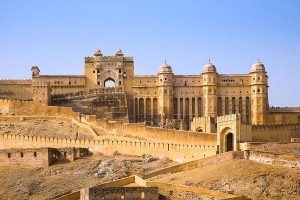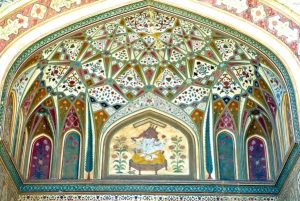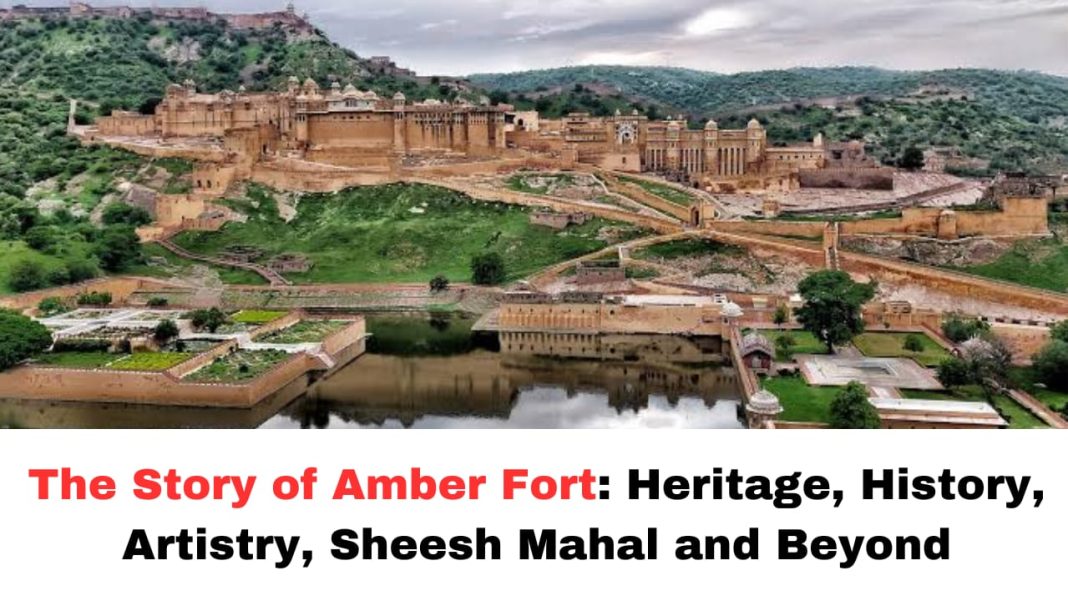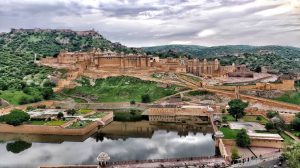Digital News Guru Rajasthan Desk:
Amber Fort: A Marvel of Rajputana Splendor
Amber Fort, also known as Amer Fort, stands as a testament to the grandeur of India’s royal heritage. Situated in Amer, a small town located approximately 11 kilometers from Jaipur, Rajasthan, this majestic fort is not only a significant tourist attraction but also a cultural icon. Constructed in the late 16th century, Amber Fort represents the zenith of Rajput and Mughal architectural fusion, captivating millions with its historical significance and artistic elegance.

Historical Overview
Amber Fort was established in 1592 by Raja Man Singh I, a trusted general of Emperor Akbar. It served as the capital of the Kachwaha Rajputs before Jaipur took over this role. Later, the fort underwent several modifications and expansions by successive rulers, particularly under Sawai Jai Singh I. Named after the goddess Amba, the presiding deity of the Meenas, Amber Fort is more than a fortification; it is a symbol of Rajasthan’s opulent past.
Architecture and Design
The fort is a masterpiece of architecture, constructed with red sandstone and white marble. It reflects a harmonious blend of Hindu and Mughal styles, embodying intricate carvings, mirror work, and ornamental detailing. Amber Fort is laid out over four levels, each with its own distinct courtyard.
- The Suraj Pol and Jaleb Chowk
Visitors enter through the Suraj Pol (Sun Gate), leading to the Jaleb Chowk, a wide courtyard where returning armies would be welcomed. This area once served as a parade ground. - The Diwan-e-Aam
The Hall of Public Audience, or Diwan-e-Aam, is a stunning open-air courtyard supported by intricately carved columns. This space was used by rulers to hear petitions from their subjects. - Sheesh Mahal (Mirror Palace)
One of the most enchanting sections of Amber Fort is the Sheesh Mahal. This small hall is adorned with countless mirrors, which reflect light to create an almost magical ambiance. Legend has it that a single candle could illuminate the entire hall due to its reflective surfaces. - Sukh Niwas
Located near the Sheesh Mahal, the Sukh Niwas, or Hall of Pleasure, features an ingenious air-cooling system. Water channels within the walls ensured a cool environment even during scorching summers. - Zenana (Women’s Quarters)
The secluded Zenana area provided a private living space for the queens and royal women. Its architecture allowed for privacy while ensuring connectivity with other parts of the fort.
Strategic Importance
Amber Fort was not merely a palace but also a strategic military stronghold. Its location atop a hill overlooking Maota Lake provided natural defense. The fort’s thick walls and strategic design ensured protection against invasions. Maota Lake served as a water source, emphasizing the fort’s self-sufficiency.
Artistic Highlights
The Amber Fort is renowned for its artistic brilliance. The fusion of Mughal and Rajput styles is evident in the detailed frescoes, floral motifs, and lattice windows. The use of marble, combined with the play of light and shadow, creates a mesmerizing visual effect.
The Sheesh Mahal, with its intricate glasswork, is the epitome of this artistry. The fort also features stunning frescoes that depict scenes from mythological epics like the Ramayana and Mahabharata, as well as floral and geometric patterns inspired by Persian art.

UNESCO World Heritage Status
In 2013, Amber Fort was declared a UNESCO World Heritage Site as part of the “Hill Forts of Rajasthan” group. This recognition underscores its cultural and architectural significance, as well as its historical importance in India’s royal legacy.
Visitor Experience
Amber Fort is one of Rajasthan’s most popular tourist destinations, attracting visitors from across the globe. The fort offers a plethora of activities and experiences:
- Sound and Light Show
Held every evening, the sound and light show narrates the history of Amber Fort, blending storytelling with music and visuals. This experience adds a magical dimension to the fort’s grandeur. - Elephant Rides
Tourists can ride elephants up to the fort’s entrance, recreating the royal experience of yore. However, this practice has been criticized for its ethical concerns, with animal welfare activists urging alternatives. - Photography and Cultural Tours
The fort’s intricate designs, expansive courtyards, and stunning views make it a photographer’s paradise. Guided tours provide a deeper understanding of its historical and architectural nuances. - Cultural Events
Various cultural programs, including traditional dance and music performances, are held at the fort, offering visitors a glimpse into Rajasthan’s rich heritage.
Conservation Challenges
Despite its grandeur, Amber Fort faces several challenges:
- Weathering and Structural Deterioration
The fort’s sandstone structure is vulnerable to weathering due to rain, wind, and temperature fluctuations. Efforts are underway to assess and mitigate these issues. - Tourism Impact
High footfall has led to concerns about wear and tear. Authorities have implemented measures to regulate visitor numbers and ensure sustainable tourism. - Ethical Concerns with Elephant Rides
Activists have raised concerns over the treatment of elephants used for rides at Amber Fort. Many advocate for replacing this practice with eco-friendly and ethical alternatives, such as electric vehicles.
How to Reach Amber Fort
Amber Fort is easily accessible from Jaipur, with various transport options:
- By Road
Local taxis, buses, and auto-rickshaws are widely available. The fort is approximately a 30-minute drive from Jaipur city center. - By Air
Jaipur International Airport is the nearest airport, connecting Amber Fort to major cities in India and abroad. - By Rail
Jaipur Railway Station is well-connected, and from there, travelers can hire local transport to reach the fort.
Why Visit Amber Fort?
Amber Fort is a microcosm of Rajasthan’s cultural and architectural wealth. Its strategic design, artistic brilliance, and historical significance make it a must-visit destination. Whether you’re a history enthusiast, architecture lover, or cultural explorer, Amber Fort offers an unparalleled experience.
Conclusion
Amber Fort is not just a historical monument; it is a living testimony to the splendor and ingenuity of India’s royal past. Its blend of artistry, history, and culture continues to enchant visitors. As we marvel at its beauty, it’s essential to ensure its preservation for future generations, striking a balance between tourism and conservation. Amber Fort remains a crown jewel of Rajasthan and a symbol of India’s rich heritage.
You May Also Read: Mysore Palace: The Heart of Karnataka’s Royal History and Cultural Legacy





